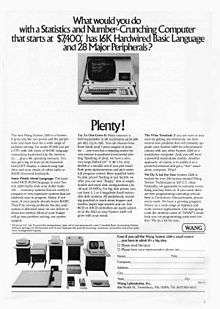Wang 2200
|
Wang 2200 Basic Computer | |
| Manufacturer | Wang Laboratories[1] |
|---|---|
| Type | minicomputer |
| Release date | May 1973[2][3] |
| Introductory price | US$7,400 (equivalent to $39,513 in 2015) |
| Units shipped | 65,000[4][5] |
| Operating system | Wang MOS(OS), BASIC |
| Memory | 4 kB of RAM (Expandable in 4 kB increments up to 32 kB) / MOS(OS) in 4 kB ROM / BASIC in 16 kB ROM[6][7] |
| Storage | cassette tape storage unit |
| Display | 16 lines x 64 Characters cathode ray tube (CRT)[8][9] |
| Input | keyboard |

The Wang 2200 appeared in May 1973, and was Wang Laboratories' first minicomputer that could perform data processing in a common computer language. Unlike some other desktop computers, such as the HP 9830, it had a cathode ray tube (CRT) in a cabinet that also included an integrated computer-controlled cassette tape storage unit and keyboard. Microcoded to run interpretive BASIC, about 65,000 systems were shipped in its lifetime and it found wide use in small and medium-size businesses worldwide. The 2200 evolved into a desktop computer and larger system to support up to 16 workstations and utilized commercial disk technologies that appeared in the late 1970s and early 1980s.[10] The disk subsystems could be attached to up to 15 computers giving a theoretical upper limit of 240 workstations in a single cluster.
Unlike the other product lines such as the VS and OIS, Wang Laboratories aggressively used value added resellers (VARs) to customize and market 2200 systems. One such creative solution deployed dozens of 2200 systems and was developed in conjunction with Hawaii- and Hong Kong-based firm, Algorithms, Inc. It provided paging (beeper) services for much of the Hong Kong market in the early 1980s.
Soviet clone
In the 1970s, Wang 2200 computers were extensively used by Gosplan and Goskomstat, the main Soviet planning and statistical agencies. The fear of backdoors in the Western hardware led to the reverse engineering of the original system and the development of the Iskra-226, a 100% binary compatible clone.
The development started in 1978, and the series production began in 1980, so the oft-cited reason of CoCom restriction in the wake of Afghan War (which started in 1980) appear to be baseless. Soviet computer historians note that the Gosplan and Goskomstat users much preferred the original Wang hardware, so the clones were mainly used by the other organizations, mainly in research and industry. It was helped by the fact that Iskra, while 100% software compatible with the Wang's T-Basic code, had completely different internal structure and included many features that made it an excellent industrial controller, such as twin high-speed RS-232 interfaces, IEEE-488 equipment control interface, and CAMAC crate control circuitry. Later a somewhat simplified Unix port was created to run on this machine.
End of production
Overshadowed by the Wang VS, the 2200 languished as a cost-effective but forgotten solution in the hands of the customers who had it. In the late 1980s Wang revisited the 2200 for one last dip in the revenue well, offering 2200 customers a new 2200 CS with bundled maintenance for less than customers were then paying just for maintenance of their aging 2200 systems. The 2200 CS was accompanied by updated disk units and other peripherals, and most 2200 customers moved up to the 2200 CS, after which Wang left the market and never again developed any new 2200-series products. In 1997 Wang reported having about 200 2200 systems still under maintenance around the world. Throughout, Wang had always offered maintenance services for the 2200.
Wang 2200 Basic2 code can run on PCs and Unix systems using compilers and runtime libraries sold by Niakwa[11] or Kerridge.[12] These allow accessing the much larger, inexpensive random-access memory and disk space available on modern hardware. The programs run many times faster than they did on the 2200 hardware.
References
- ↑ Advertisement:Wang 2200, New Scientist - 18 Nov 1976 - Page 389, This computer makes medical history
- ↑ Programmable Calculator Uses Basic, Costs $6,700, Computerworld - 1 Nov 1972, ...Users can get a complete Basic language oomputer system with the Wang 2200 Advanced Programmable Calculator for $6,700 from...
- ↑ Advertisement:Wang 2200, Computerworld - 26 Nov 1975 - Page 13, Wang happens to make a better small computer than IBM. The Wang 2200 computer versus the IBM 5100 computer. When you make a few simple comparisons, you'll find there simply is no comparison.
- ↑ Advertisement:Wang 2200, New Scientist - 14 Apr 1977 - Page 85, The Wang 2200 is now two years and 7000 units old
- ↑ Wang 2200 Sales Boost Record Net, Computerworld - 7 Aug 1974 - Page 46, Wang said it has sold around 2,300 of its 2200 line since June 1973.
- ↑ Advertisement:The WANG 2200, New Scientist - 14 Mar 1974 - Page 692
- ↑ A Standout in Its Price Range Wang 2200VP Benchmark Results Spectacular, By Hillel Segal, Computerworld - 21 Apr 1980 - Page 12
- ↑ Advertisement:Wang 2200, Computerworld - 5 Dec 1973 - Page 9, The new Wang System 2200. What you see is what you get. You get a lot for under $7,000*.
- ↑ Controller Allows Wang 2200 To Emulate IBM 2780 Format, Computerworld - 3 Dec 1975 - Page 21
- ↑ Wang Offers End Users Portable Unit, Workstations, By Esther Surden, Computerworld - 5 Apr 1976 - Page 35, ...the 2200 PCS portable system...Model 2200WS workstation...
- ↑ Niakwa
- ↑ Kerridge
External links
- Wang 2200 Extensive information about the Wang 2200
- Wang 2200 Emulator A true emulator of the Wang 2200
